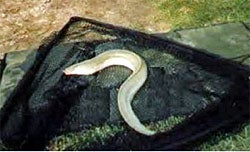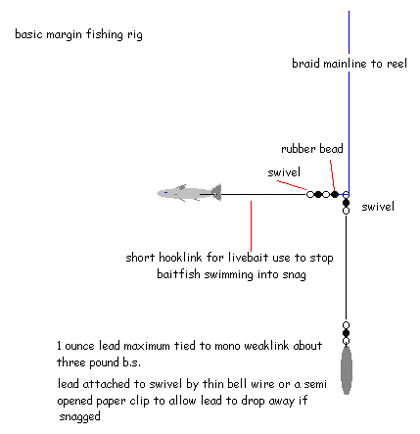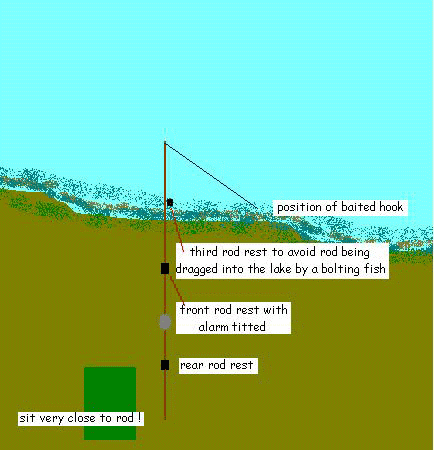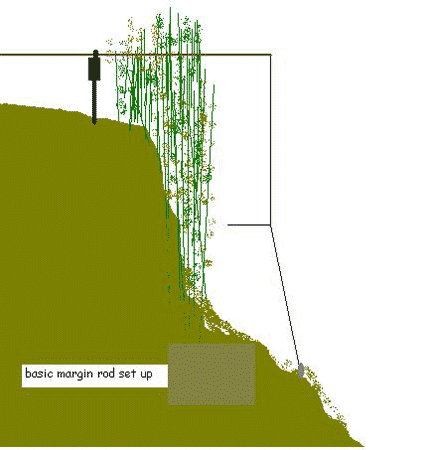Over my last few sessions I have been using a third rod purely for close-in margin fishing. By the term close-in that’s exactly what I mean…literally under my feet, no more than a few inches at the most from the marginal reed growth. Fishing this close needs dedicated tackle: it needs to be strong enough to contain the initial rush from a hooked eel, but have enough give in the top section to absorb the lunges and the head shakes from the fish on a short line, especially when using braided lines. I have found a braided main line much better for margin fishing, as having very little stretch allows you to apply maximum pressure from the start, and not allow the eel any slack line at all; a vital factor as the eel will be inches from snags.
Tackle After a lot of searching in the local tackle shops, I found something which looked as though it may have potential, not one of the £ 100+ jobs, but a £ 15 cheap ‘starter carper’ rod. It was described as having an all through action, and it does….it bends right through the handle, which I found most alarming to start with, but now I am used to it, it has proved to be ideal for margin fishing. The rod is a Shakespeare Mentor carp, 11′ long, and has a test curve of 2.5 lb, and comes with the usual reel seat and three foam grips, and an awful set of rings, more suited to a beachcasting rod. I had the shop completely re-ring the rod for me with a set of seven decent sized rings, which cost me more than the rod did to start with, but it seems to have been worth the expense. Finding a reel was next on the agenda as my two new Penn Big Pits were somewhat too big for the job. I already had an old but good Silstar Eurostar 50 in the back of my cupboard, long retired from front line duties, which I gave a good service and grease up, and set about filling the thing up with some decent line. On one spool I have used 12lb mono with a 100 metre spool of 15lb Dyneema braid on top, and the other spool has 12lb Berkley Trilene mono straight through. Rigs After giving the matter considerable thought (a pretty painful experience for me) I settled on a rig which has proved it’s worth a few times now, and one which I shall continue to use and modify as I go on. The rig in question is basically a paternoster rig, with a few added details to suit my requirements, as can be seen from the diagram below. I have tried to make the rig fish friendly, so that if an eel does snag me and breaks off with the rig attached, the lead will drop away, leaving the fish free to lose the hook it’s own way, and not tethered by a lead to the snag.
Another benefit of margin fishing is that heavy leads are not needed, I only use a maximum of one ounce leads, and if I am fishing in calm conditions, then a simple freelined set up is used, and the baited hook just lowered into the water. If using a freelined set up, all I do is just tighten up as far as is practical and attach the lightest bobbins I have, but for more inclement weather conditions, I will use a reasonably heavy bobbin. Both are used in conjunction with electronic bite alarms. I always margin-fish using a closed bale arm, and the reel’s clutch set to almost maximum. The whole object of margin fishing is not to allow any eel that I hook to have any slack line at all, because it will be in the snags before I can grab the rod. The rod is set up on three bank sticks…one rear support, one at the front with the alarm fitted, and another about 3/4 up the rod’s length, and offset to the side, nearest to the direction to which I have placed my bait. This is easier to show than to describe, so refer to the diagram below. This stops any bolting eel dragging the whole rod into the lake, and will give me precious seconds to react to the run. I always sit very close to the rod, and at the slightest sign of interest my hand is in position on the rod ready to strike and pull the fish away from the margins and out into more open water…hopefully !
Baits No living creatures were harmed as an off shoot of my weird interests! Baits such as frogs are attached to the single hook rig by a few twists of bait elastic around the body. A small mouse I attach by threading the trace up through the animal’s body with a baiting needle, from vent to mouth, with the hook coming out at the mouth end, and for small birds I use a miniature pennel rig with size 4 hooks, and simply lay the rig along the bird’s body and wind a few turns of bait elastic over each hook. Dead day-old chicks are also a good bait, I am reliably informed, but as yet I’ve never tried them. They are easily available from pet stores that specialise in snakes and reptiles, and are quite cheap to buy. Technique
Having set up my chair and organised the important cup that cheers, the rod rests are then set up as per the diagram, and the rod tackled up ready. If there was no departing angler to prebait the swim for me, now is the time I will introduce some attractions of my own. This is normally a mix of tinned cat food, mashed whitebait or sprats, a good dollop of pilchard oil and sometimes a handful of chopped lobworms. The resulting mix is applied along the margins in a ‘spoke of a wheel’ shape, to lay a trail of scent and small food items for the patrolling eels to home in on. I then gently lower my bait into the centre of the wheel, set the rod up on the three rests, and making sure that the clutch is set in an almost fully locked position. I’m then about ready to commence. Never take your eyes off the bobbins when margin fishing, because the majority of takes are vicious attacks with no pre warning twitches. One second you are watching a stationary bobbin, and the next second the bobbin has hit the rod butt and the rod is being pulled round in tight curve, dancing in the rod rests as it does. Now you see the need for that third rod rest! Hit the bite, and don’t allow the eel any slack line at all, or it will be in the margin weed growth and snagged tight. Pull the eel out into open water and let the fight continue in a clear area. But take note here, some eels I have hooked when fishing very tight in like this seem stunned at being dragged out and away from snags in a rush, and just when you are starting to relax a bit, they seem to get a second wind, and if you are not on the ball, they will head back into cover like lightning. Hit them and hold on tight, pull them away from the margin snags and keep the pressure on all the time. You can walk down to a fish and alter the angle of pull if needs be – another benefit of margin fishing. My last session of margin fishing at my local carp lake produced a superb four pound eel for me, in broad daylight, using the methods and ideas as detailed above. I had moved into a swim left by a departing long stay carp angler, and watched him gratefully as he emptied bags of unused groundbait into the waters edge, and looked on as the residue attracted a large shoal of fry and immature roach and rudd. He couldn’t have got more than a hundred yards away as I lowered a roach tail section into the melee of fish under my feet, and as I lowered the rod onto the rests and attached the bobbin, it was ripped out of my fingers by the force of the attacking eel. I netted the fish some ten minutes later, and as I watched it swim gracefully away after the photos had been taken, I silently thanked my departed carp angler. Give my ideas a try, I wish you as much success as I have had using this old fashioned but deadly method. |
Welcome!Log into your account














